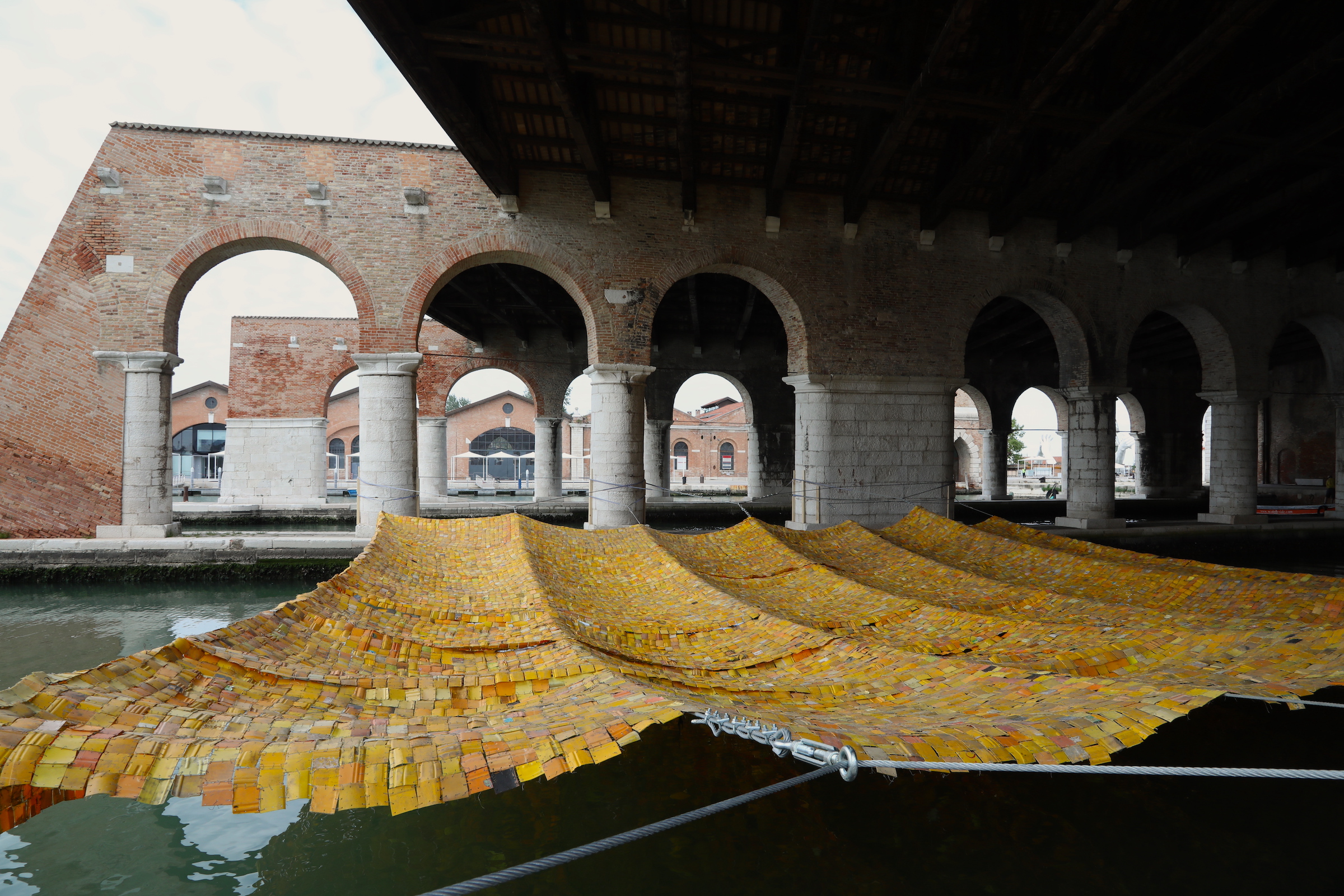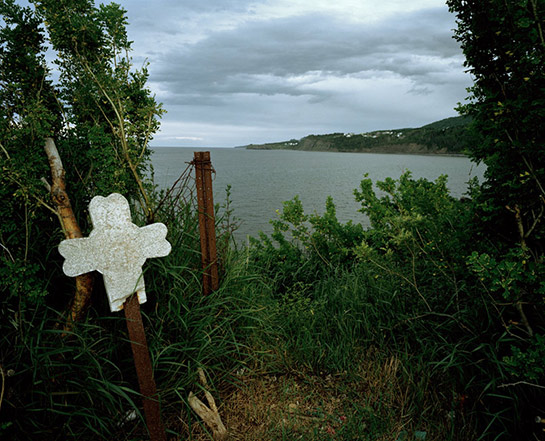VENICE — The 18th International Architecture Exhibition that opened to the public in Venice last week and runs through November 26 differs from previous iterations of the biennial in significant ways, but perhaps most notably in its emphasis on reusing and recycling materials. Participants this year were asked to leave as light a carbon footprint as possible, encouraged to use screens, projections, and digital resources “in place of models and artifacts.”
These features are in line with one of two guiding principles in Ghanaian-Scottish curator Lesley Lokko’s vision: “decarbonization.” The other, “decolonization,” is reflected in the show’s geographic focus. For the first time, more than half the participants of the Biennale are either African or from the African diaspora.
For all the Biennale’s stress on decolonization and the empowerment of African architects and artists, the denial of visas to three Ghanaian members of Lokko’s team, allegedly over fears that they might overstay their visit, tarnished the host country’s hospitality credentials. During the inaugural press conference, Lokko read a statement by the Italian embassy in Ghana claiming that it was “at the forefront of policies to promote African cultural heritage.” The visa rejections, Lokko added, “were not the forefront of policy” but the “ugly rear.”
This incident, Lokko said, should not define the 18th International Architecture Exhibition, which comes with so many firsts. The look and feel of the Biennale defy our traditional expectations of an architecture show, and a walk through the main venues — the vast park of the Giardini, with pavilions that include works by Carlo Scarpa and Alvar Aalto, among other renowned architects; and the Arsenale, the ancient shipyard of Venice — confirms the accuracy of the show’s title: The Laboratory of the Future. The idea that architecture should transcend the realm of construction and address people’s needs, especially in the wake of the COVID-19 pandemic, is at the heart of this exhibition.
In the Arsenale, a triangular timber tower titled “Kwaeε” (“forest” in Twi, one of the languages spoken in Ghana) by Ghanaian-British architect David Adjaye stands out for its monumentality while simultaneously blending into its Venetian setting. The interior of the tower is a sculpted ovoid described in the Biennale brochure as reminiscent of a cave, yet its sensorial effect conveys a sense of the sacred, helped by two oculi near the apex, one opening to a disused crane and the other to the unobstructed sky.


Another outstanding work from Africa comes also from Ghana. Artist Serge Attukwei Clottey has created a massive quilt out of recycled pieces of plastic jerrycans that are reused as water containers. Known locally as “Kufuor Gallon” or “the Gallon,” they are ubiquitous in Accra, Ghana’s capital, which suffers from a chronic water shortage. The containers take their name from John Kufuor, Ghana’s president from 2001 to 2009, a period when the country experienced a series of water crises.
Plastic, too, is the central theme of the United States pavilion. Venturing outside of his usual medium, Chicago-based designer Norman Teague has recycled plastic to reinterpret traditional Bolga baskets from a district in Ghana known for its handicrafts and the Agaseke baskets of Rwanda. The presentation is meant as a critique of Western exploitation — “extractivist practices” — by which the resources taken from developing countries return to their source as refuse. The pavilion drives home the point of the overwhelming presence of plastic in daily life in the US.
“We are looking at this reality about plastic and how reduce-reuse-recycle has been a very tired trope, and it puts the onus on the individual and not on the corporations who are truly responsible for our global crisis,” said Tizziana Baldenebro, co-curator of the US pavilion along with Lauren Leving.
According to Baldenebro, our individual relationships to plastic have become “abstract and obscure.” Her project seeks to engage viewers, and users of plastic, through artwork created with what is now one of the world’s worst pollutants.
Also in the US pavilion, Simon Anton from Detroit has grafted plastic onto metal sculptures to recreate the hypothetical future remains of a catastrophic past. The effect of the colorful fragments on crowd-control barriers or the bent window grills of the Federal Reserve Bank in New York evoke an ancient shipwreck covered in seashells.
“The plastic flakes speak to how communities of color and lower-income communities are disproportionately affected by plastic waste,” said Anton. “It is a kind of environmental violence.”

Exciting as it may be, a laboratory may not please everyone. As in every experiment, we only see isolated pieces of a larger object or process that is still incomplete or is hard to envision in its final form by an outsider — or might turn out to be a total failure. Lokko recognizes this aspect.
“One journalist remarked that the exhibition ‘seems to stop short of architecture,’” Lokko said. “Whilst I appreciate and understand the comment, for me the opposite is true: It is our conventional understanding of architecture that stops short.”
The invitation to recycle and abstain from erecting massive structures has led to a predictable reliance on the audiovisual medium, but an abundance of footage and photography and the increasingly rich range of options offered by digital resources cannot make up for a sense of volume, even when allowing for a broader conception of architecture. Aquatic themes comprehensively explored in the Greek and Danish pavilions feel quite fitting in Venice, a city barely above the waterline, crisscrossed by 150 canals. But like many others — including the richly illustrated exhibitions of the Peruvian Pavilion and Brazil’s Terra, which won the Golden Lion, with their critical introspection into wealth and inequities in the Amazonian immensity — these presentations mostly relegate the visitor to a passive role.

Some participants, however, have achieved remarkable experiments with an economy of resources. The Korean Pavilion’s 2086: Together How? brings together architects, community leaders, and artists to explore how people can face environmental crises together until 2086, when the global population is expected to peak. It includes an addictive video game in which participants sit in stands similar to those of TV quiz shows and are given 20 seconds to answer a series of questions that border on the impossible or the absurd. The prompts convey a sense of urgency about the state of the planet. Has AI taken over our lives? What would you do if rising sea levels forced you to leave your home?
Misleading in its austerity, the Poland Pavilion displays four sets of interlocked frameworks that represent the dimensions and spatial forms of homes in four countries or territories: Poland, Mexico, Hong Kong, and Malawi. Visitors can traverse them to get a sense of the living spaces, whose measurements are based on average data. While the installation faithfully reflects this information, it does not correspond to housing reality in any of the four regions. The pavilion is titled Datament, a neologism meant to signify “the establishment of data.” In the work description, the Polish team — made up of artist Anna Barlik, architect Marcin Strzata, and curator Jacek Sosnowski — alert to the “staggering” amount of data generated daily which the human mind can no longer process, resulting in the “seemingly chaotic and absurd structures.”

Romania’s pavilion offers a collection of singular futuristic items that date back to the early 20th century all the way to the late 1960s, with the star attraction being the Persu, a narrow, oddly elongated automobile prototype built in 1922–23 with an extraordinary aerodynamic perfection that is remarkable even today, even if it never went into mass production. This pavilion also features the Flying Backpack, the quintessential futuristic device invented by Romanian engineer Justin Capră in 1956.
For those looking for a more traditional experience, Uzbekistan’s pavilion may be rewarding. Unbuild Together: Archaism vs. Modernity, the project curated by KO Studio, reproduces in its sublime austerity the qalas, ancient fortresses of the Karakalpakstan. The focus is the most basic unit of construction, the brick. As an exquisite detail, some bricks are glazed by Uzbek artist Abdulvahid Bukhoriy, one of the few craftsmen to master the almost extinct Blue Bukhara ceramics technique.

One need look no further than Chile to find a perfect summary of what a vision for the future of architecture may be. Moving Ecologies presents an almost oval or circular perimeter described as a “Field of Experiences,” with glass spheres which contain 250 different seeds. This expanse of transparent spheres atop long sticks — think of a large flower bed with tall stems — is divided into five different sections, according to the properties of the seeds (species capable of colonizing highly degraded urban soils; species capable of remediating soils; those that help for restoration after natural disasters, and others). The installation encapsulates the words of curator Gonzalo Carrasco Purull, which perhaps contain a larger lesson for the essence of all human-made structures: “It is not architecture that dictates how we should live, but the Earth.”



